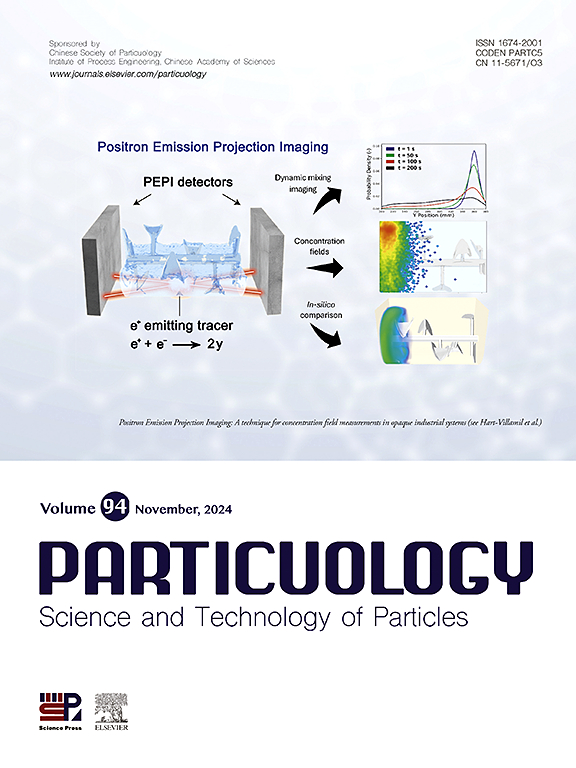Numerical study of granular flow impacting hemi-spherical structures on steep terrains by a two-phase model with μ(I) rheology closure
IF 4.1
2区 材料科学
Q2 ENGINEERING, CHEMICAL
引用次数: 0
Abstract
Granular flow is prevalent in natural disasters such as landslides and avalanches. Investigating the impact characteristics and load variations of granular flows on structures is vital for disaster prevention and mitigation. This study employs a three-dimensional continuum model combined with the Volume of Fluid method, treating the particle phase as a non-Newtonian fluid based on the μ(I) constitutive model. A numerical solver for non-Newtonian two-phase flow capable of describing granular flows on complex terrains has been implemented. Through simulations of a typical laboratory-scale three-dimensional granular column collapse problem, we present spreading processes and deposition distributions which agree with the experimental results, thereby validating the effectiveness of our numerical approach. Using this model, we examine the dynamic interactions between granular flows and single hemispherical obstacles on steep terrains. The predictions regarding depth-time curves at several critical probes and final deposition profiles demonstrate superior accuracy compared to previous forecasts based on depth-averaged models. Additionally, an analysis of the evolution of impact forces exerted by granular flows on obstacles reveals that shoulder obstacles can significantly mitigate impact forces within primary flow regions. We also give the plugging characteristics of the granular flow near the front of the obstacles. In contrast to traditional depth integration models, our methodology offers enhanced insights into three-dimensional flow dynamics and loading characteristics, providing valuable references for disaster prediction and assessment in practical engineering.

基于μ(I)流变闭合两相模型的陡坡上颗粒流对半球形结构影响的数值研究
颗粒流在山体滑坡、雪崩等自然灾害中普遍存在。研究颗粒流对建筑物的冲击特性和荷载变化对防灾减灾至关重要。本研究采用三维连续介质模型结合流体体积法,基于μ(I)本构模型将颗粒相视为非牛顿流体。实现了一种能够描述复杂地形上颗粒流的非牛顿两相流数值求解器。通过对一个典型的实验室尺度三维颗粒柱崩塌问题的模拟,得到了与实验结果一致的扩展过程和沉积分布,从而验证了数值方法的有效性。使用该模型,我们研究了陡峭地形上颗粒流和单个半球形障碍物之间的动态相互作用。与之前基于深度平均模型的预测相比,在几个关键探头和最终沉积剖面上对深度-时间曲线的预测显示出更高的准确性。此外,对颗粒流对障碍物施加的冲击力演化的分析表明,肩部障碍物可以显著减轻原生流区域内的冲击力。给出了障碍物前方附近颗粒流的堵塞特性。与传统的深度集成模型相比,我们的方法可以更好地了解三维流动动力学和载荷特性,为实际工程中的灾害预测和评估提供有价值的参考。
本文章由计算机程序翻译,如有差异,请以英文原文为准。
求助全文
约1分钟内获得全文
求助全文
来源期刊

Particuology
工程技术-材料科学:综合
CiteScore
6.70
自引率
2.90%
发文量
1730
审稿时长
32 days
期刊介绍:
The word ‘particuology’ was coined to parallel the discipline for the science and technology of particles.
Particuology is an interdisciplinary journal that publishes frontier research articles and critical reviews on the discovery, formulation and engineering of particulate materials, processes and systems. It especially welcomes contributions utilising advanced theoretical, modelling and measurement methods to enable the discovery and creation of new particulate materials, and the manufacturing of functional particulate-based products, such as sensors.
Papers are handled by Thematic Editors who oversee contributions from specific subject fields. These fields are classified into: Particle Synthesis and Modification; Particle Characterization and Measurement; Granular Systems and Bulk Solids Technology; Fluidization and Particle-Fluid Systems; Aerosols; and Applications of Particle Technology.
Key topics concerning the creation and processing of particulates include:
-Modelling and simulation of particle formation, collective behaviour of particles and systems for particle production over a broad spectrum of length scales
-Mining of experimental data for particle synthesis and surface properties to facilitate the creation of new materials and processes
-Particle design and preparation including controlled response and sensing functionalities in formation, delivery systems and biological systems, etc.
-Experimental and computational methods for visualization and analysis of particulate system.
These topics are broadly relevant to the production of materials, pharmaceuticals and food, and to the conversion of energy resources to fuels and protection of the environment.
 求助内容:
求助内容: 应助结果提醒方式:
应助结果提醒方式:


